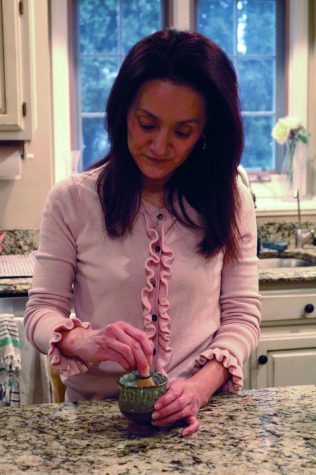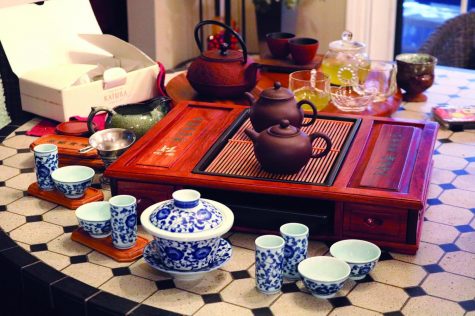It is dinner time and as junior Remi Shirayanagi eats she takes sips of brown tea on the side. Remi said that all of her family drink tea together, mostly at mealtimes.
“I drink tea like I do water,” Remi said.
Remi said tea drinking has been a prevalent part of her life as she is of both Japanese and Chinese descent. She said the box of tea in her fridge is always full, and its contents mostly consists of brown tea.
 Remi, who said she identifies with her Japanese heritage more than her Chinese heritage, said tea is an important part of Japanese everyday life. It is a major part of her memories of her times with her grandparents. She said tea is something that was intrinsically ingrained in her culture, which she said helped her create a strong preference for the beverage.
Remi, who said she identifies with her Japanese heritage more than her Chinese heritage, said tea is an important part of Japanese everyday life. It is a major part of her memories of her times with her grandparents. She said tea is something that was intrinsically ingrained in her culture, which she said helped her create a strong preference for the beverage.
January is Hot Tea Month and even though tea is a personal preference for some, it is very important to the Asian community according to Chinese teacher Tungfen Lee. Lee said, via email, that tea is extremely important to the Chinese community in particular as it is the country’s national beverage.

Similarly, tea holds a lot of importance to the Japanese community as well. According to Ikue Shirayanagi, Japanese interpreter and Remi’s mother, tea is an important part of social life in Japan. Mrs. Shirayanagi said different types of tea are used in different social situations. She said if a homeowner has guests over, for example, they will serve the guests green tea and sweets. If a person is invited to a tea ceremony, they will be served high-end, expensive tea. She also said people mostly drink brown tea in the comfort of their own home.
According to Lee, there is a set of etiquettes that are vital to the serving of tea in both formal and casual occasions. Lee said tea is a necessity in a Chinese person’s life and that tea can be found anywhere, from convenience stores to cafés dedicated to tea.
Mrs. Shirayanagi also spoke of the rich history behind traditional tea ceremonies in Japan. What started a thousand years ago with tea served on tatami mats (a type of mat that is used as flooring in traditional Japanese rooms, traditionally made of rice straw) evolved into a sophisticated tea ceremony that is held in high esteem today, she said.
“If you are invited to that kind of a tea party it’s more like a privilege. It’s (an) honor to attend that tea party,” Mrs. Shirayanagi said. She also said there is a certain expectation of behavior from the attendees, such as wearing a kimono to the ceremony. Furthermore, one has to greet the hosts of the tea ceremony properly, and know how to drink the tea.

According to Mrs. Shirayanagi, the method of consuming tea changes with the type being served at the ceremony.
She said, “There are many, many etiquettes, because (in one instance), you bring (the teacup) up, turn (it) twice, and then drink a little bit of it. And sometimes, depending on tea, we share one cup of tea with all the attendees, it’s not common, but there is etiquette like it.”
“Those kinds of (teacups) are inherited by generations,” Mrs. Shirayanagi added, “They’re like heirlooms, so (the teacups are) a very special thing, like an antique many times, (so) you are enjoying the tea and the (beauty of the) tea-cup as well.” She said that there are two different types of cups. The ones that are used by the family are taller and don’t have handles like mugs in the west. Teacups that are served to the guests are shorter and come with saucers. They are white on the inside, so the guests can see the beauty of the green tea that is served in the cup.

Besides the cultural significance of tea, Remi said that tea is something that is the center of many small happy memories.
She said, “We drink tea a lot, pretty much with every meal and my mom and I and my brother like to talk while we drink tea sometimes too.”
Remi also said she drinks tea while studying and in the morning for a boost of caffeine.
On top of the comfort of a warm drink, Remi said the many different types of tea was a major factor in deciding their preference of tea over coffee.
Regardless of the different varieties and the rich history behind tea, Remi, Lee and Mrs. Shirayanagi all said that they find tea to be comforting and to be a constant in their lives.
(Read about types of tea from around the world)































![What happened to theater etiquette? [opinion]](https://hilite.org/wp-content/uploads/2025/04/Entertainment-Perspective-Cover-1200x471.jpg)














































![Review: “The Immortal Soul Salvage Yard:” A criminally underrated poetry collection [MUSE]](https://hilite.org/wp-content/uploads/2025/03/71cju6TvqmL._AC_UF10001000_QL80_.jpg)
![Review: "Dog Man" is Unapologetically Chaotic [MUSE]](https://hilite.org/wp-content/uploads/2025/03/dogman-1200x700.jpg)
![Review: "Ne Zha 2": The WeChat family reunion I didn’t know I needed [MUSE]](https://hilite.org/wp-content/uploads/2025/03/unnamed-4.png)
![Review in Print: Maripaz Villar brings a delightfully unique style to the world of WEBTOON [MUSE]](https://hilite.org/wp-content/uploads/2023/12/maripazcover-1200x960.jpg)
![Review: “The Sword of Kaigen” is a masterpiece [MUSE]](https://hilite.org/wp-content/uploads/2023/11/Screenshot-2023-11-26-201051.png)
![Review: Gateron Oil Kings, great linear switches, okay price [MUSE]](https://hilite.org/wp-content/uploads/2023/11/Screenshot-2023-11-26-200553.png)
![Review: “A Haunting in Venice” is a significant improvement from other Agatha Christie adaptations [MUSE]](https://hilite.org/wp-content/uploads/2023/11/e7ee2938a6d422669771bce6d8088521.jpg)
![Review: A Thanksgiving story from elementary school, still just as interesting [MUSE]](https://hilite.org/wp-content/uploads/2023/11/Screenshot-2023-11-26-195514-987x1200.png)
![Review: "When I Fly Towards You", cute, uplifting youth drama [MUSE]](https://hilite.org/wp-content/uploads/2023/09/When-I-Fly-Towards-You-Chinese-drama.png)
![Postcards from Muse: Hawaii Travel Diary [MUSE]](https://hilite.org/wp-content/uploads/2023/09/My-project-1-1200x1200.jpg)
![Review: "Ladybug & Cat Noir: The Movie," departure from original show [MUSE]](https://hilite.org/wp-content/uploads/2023/09/Ladybug__Cat_Noir_-_The_Movie_poster.jpg)
![Review in Print: "Hidden Love" is the cute, uplifting drama everyone needs [MUSE]](https://hilite.org/wp-content/uploads/2023/09/hiddenlovecover-e1693597208225-1030x1200.png)
![Review in Print: "Heartstopper" is the heartwarming queer romance we all need [MUSE]](https://hilite.org/wp-content/uploads/2023/08/museheartstoppercover-1200x654.png)




